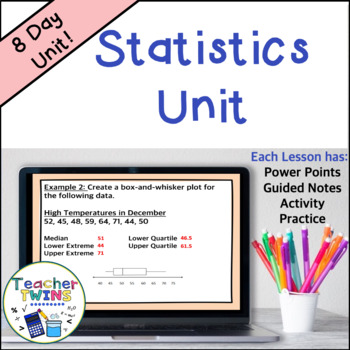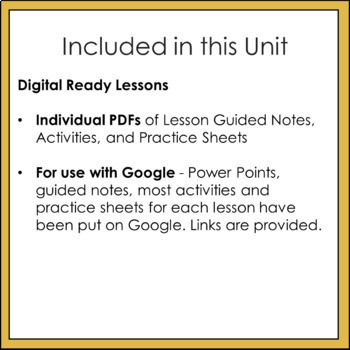Statistics Unit - Mean Absolute Deviation - Populations and Samples - Box Plots
- Zip
- Google Apps™

Also included in
- Don't have time to plan your math lessons? We have what you need! Try our 7th Grade Math Curriculum Bundle. It contains 14 NO PREP Units and an End-of-Year Review. The units are very easy to use and will save you a lot of time! Review important math concepts with your students by using our editablePrice $145.00Original Price $187.00Save $42.00
Description
Make lesson planning easy with this no-prep Statistics - Mean Absolute Deviation - Populations and Samples - Box-and-Whisker Plots Unit! Included are 8 ready-made lessons to teach finding mean absolute deviation as well as interpreting and creating box-and-whisker plots. This unit is very easy to use and will save you a lot of time!
Your students will learn how to find mean absolute deviation and interpret box-and-whisker plots by using our editable PowerPoints with guided notes. Students will love learning about statistics when you use the included activities for each lesson!
Lessons Included in Statistics - Mean Absolute Deviation - Populations and Samples - Box-and-Whisker Plots Unit
1). Populations and Samples
2). Mean, Median, Mode
3). Measures of Variation
4). Box-and-Whisker Plots
5). Mean Absolute Deviation
6). Football Statistics
7). Statistics Test Review
8). Statistics Test
Click the link below for a FREE sample lesson on Writing Expressions and Equations from the 7th Grade Expressions and Equations Unit. It includes a PowerPoint as well as an activity and a practice sheet.
FREE Writing Expressions and Equations
Included in Statistics - Mean Absolute Deviation - Populations and Samples - Box-and-Whisker Plots Unit
- Editable PowerPoints for each lesson (see the list of lessons below).
- Each PowerPoint has a warm-up, notes, and a lesson closure.
- Editable Guided Notes and/or flippables for each PowerPoint Lesson.
- Activities for each lesson.
- Editable Practice Sheets for each lesson.
- Test Review Activity for the unit.
- Editable Test for the unit.
- Answer keys are included.
- Individual PDFs of guided notes, practice sheets, and activities are also provided if you would like to use the lesson digitally.
- For use with Google - The PowerPoints, guided notes, activities, and practice sheets also have a version in Google Slides to be used for digital learning.
This Statistics - Mean Absolute Deviation - Populations and Samples - Box-and-Whisker Plots Unit makes planning your math lessons a breeze! Your students will be engaged in math class by moving around and working with others while playing games and solving puzzles.
Lesson Planning is quick and easy! Use the populations and samples, mean absolute deviation, and box-and-whisker plot PowerPoint lessons provided along with the guided notes. You also have an activity and practice sheet for the lesson that you can print. Just gather the materials you need for the day and you are ready to go!
If you have access to technology and would like to reduce paper use with your students we have all of the materials available as a Google Slide that students can use.
Hear What Teachers are Saying about Statistics - Mean Absolute Deviation - Populations and Samples - Box-and-Whisker Plots Unit
⭐️⭐️⭐️⭐️⭐️ This is clearly set out for the learners to use. Great job and thanks. -Haley M.
⭐️⭐️⭐️⭐️⭐️ Time Saver! Thanks -Kathryn P.
⭐️⭐️⭐️⭐️⭐️Loved this so much that I am buying another unit! Thank you TeacherTwins! -Kaitlyne E.
⭐️⭐️⭐️⭐️⭐️ perfect for the standard -Laura B.
⭐️⭐️⭐️⭐️⭐️I love all of your units and the activities that go with it. Thanks for creating wonderful products! -Tamala M.
This unit is aligned to Common Core Math Standards for 7th grade. Please note that you may need to use supplemental resources for topics that are not covered. You may also need more time on a certain topic than is given in the unit depending on the needs of your students.
___________________________________
For Sixth Grade Math Units
For Seventh Grade Math Units
For Eighth Grade Math Units
You may also like…
→Mean, Median, and Mode Scavenger Hunt
→7th Grade Statistics Summer Escape
Be sure to follow the Teacher Twins store for new products! CLICK HERE
___________________________________
Copyright © Teacher Twins
Permission to copy for single classroom use only.
Please purchase additional licenses if you intend to share this product.






